Last Updated on January 17, 2025 by Kittredge Cherry
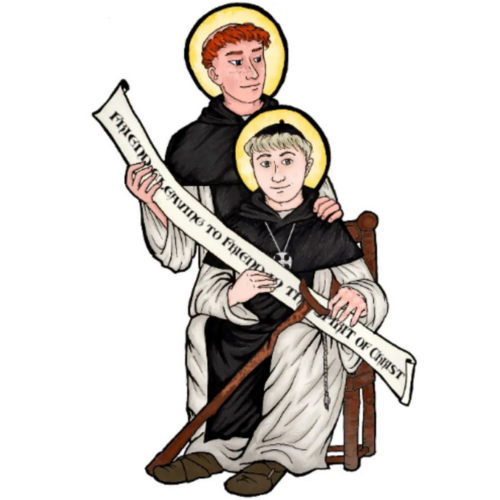
Aelred of Rievaulx is considered one of the most lovable saints, the patron saint of friendship and also, some say, a gay saint. He found divine love through friendships with other men.
Aelred (1109-1167) was the abbot of the large, influential Cistercian abbey of Rievaulx in northeastern England. His treatise “On Spiritual Friendship” (De Spirituali Amicita) is still one of the best theological statements on the connection between human love and spiritual love. “God is friendship… He who abides in friendship abides in God, and God in him,” he wrote, paraphrasing 1 John 4:16.
 The English abbot’s own deep friendships with men are described in the classic book Christianity, Social Tolerance, and Homosexuality
The English abbot’s own deep friendships with men are described in the classic book Christianity, Social Tolerance, and Homosexuality by Yale history professor John Boswell. “It was Saint Aelred of Rievaulx who gave love between those of the same gender its most profound and lasting expression in a Christian context…. There can be little question that Aelred was gay and that his erotic attraction to men was a dominant force in his life,” Boswell wrote. During his lifetime he was a nationally important historian who wrote the biographies of two kings (Henry II and Edward the Confessor), but his writings on human relationships seem to resonate more widely today. His feast day is Jan. 12 in Episcopal, Anglican and Catholic churches, and Feb. 3 among the Cistercians.
Aelred is the favorite LGBTQ saint of many Q Spirit readers. He is little known among Catholics, but his huge popularity with Anglicans and Episcopalians more than makes up for his lack of name recognition in Catholic circles. While many historical saints come from the Middle East or Mediterranean Europe, Aelred has special appeal for English speakers as a homegrown saint who lived his whole life in England (although he wrote in Latin).
Boswell’s account inspired some LGBTQ religious groups to choose him as their patron saint, including the U.S. Episcopal group Integrity and the Order of Saint Aelred in the Philippines. Click here for details of how Integrity won official church recognition for their gay saint in 1987. (Integrity went into decline and dissolved as a non-profit corporation in January 2022, according to an Episcopal News Service report.)
Aelred affirmed friendship among monks
Aelred certainly advocated chastity, but his passions are clear in his writing. He describes friendship with eloquence in these often-quoted passages from his greatest work, On Spiritual Friendship (De spirituali amicitia):
“Friend cleaving to friend in the spirit of Christ, is made with Christ but one heart and one soul, and so mounting aloft through degrees of love to friendship with Christ, he is made one spirit with him in one kiss.”
…and in another section…
“It is no small consolation in this life to have someone who can unite with you in an intimate affection and the embrace of a holy love, someone in whom your spirit can rest, to whom you can pour out your soul, to whose pleasant exchanges, as to soothing songs, you can fly in sorrow… with whose spiritual kisses, as with remedial salves, you may draw out all the weariness of your restless anxieties. A man who can shed tears with you in your worries, be happy with you when things go well, search out with you the answers to your problems, whom with the ties of charity you can lead into the depths of your heart; . . . where the sweetness of the Spirit flows between you, where you so join yourself and cleave to him that soul mingles with soul and two become one.”

Every line of Aelred’s famous quote on friendship is illustrated by Jan Haen in his 2022 book “Heavenly Homos, Etc.: Queer Icons from LGBTQ Life, Religion, and History.”
Aelred supported friendships between monks, comparing them to the love between Jesus and his beloved disciple, and between Jonathan and David in his treatise on spiritual friendship. Louis Crompton, professor of English at the University of Nebraska, reports in Homosexuality and Civilization that Aelred allowed the monks at his Yorkshire monastery to express affection by holding hands, a practice discouraged by other abbots.
Aelred is perhaps the best-known theologian of friendship, but others who developed in-depth theologies of same-sex friendship include 17th-century English Puritan Richard Sibbes and 20th-century Russian Orthodox priest Pavel Florensky.
Aelred had a lifetime of friendships with men
Aelred was born in 1110 in the Yorkshire area of northeastern England near the Scottish border in the small town of Hexham, Northumbria. The region was steeped in Celtic traditions, including the concept of two devoted friends mingling souls as “anam cara” (soul friends). The son of a married priest and his wife, Aelred came from a long line of married priests, a role handed down for four or five generations. But when he was 13, the Catholic church ruled that priests could no longer marry or pass on their property and titles to their sons. Excluded from the system of hetereosexual marriage, Aelred had to imagine a new social structure, not unlike queer people today.
The queer ramifications of Aelred’s life are examined in the chapter about him in “The Double: Male Eros, Friendships, and Mentoring–from Gilgamesh to Kerouac” theology professor emeritus Edward Sellner. He notes that Aelred’s great-grandfather was the sacristan who tended the dead body of Saint Cuthbert, who had a close male companion named Boisil at the monastery of Melrose.
Around age 14 or 15, Aelred was sent to study at the court of King David I of Scotland. He stayed there for about a decade until age 24. While rising to the rank of steward, he reveled in friendships. “I delighted in the pleasure of being with my friends more than in anything else…. Nothing was more pleasant or more delightful or more useful than to seem to be loved and love in return,” he wrote in his book “On Spiritual Friendship.”
Apparently his special friend was the king’s stepson, Waldef or Waltheof of Melrose. Like Aelred, he later became a saint. According to American Trappist scholar Thomas Merton, Aelred formed “ties of the most intimate friendship” with Waldef.
Aelred admitted to the “loss of my chastity” during his years at court, and experienced inner turmoil over tie. “Taking all of this into account, as well as Aelred’s later descriptions of his love for certain men AFTER he joined the monastery at Rievaulx, it seems highly likely that Aelred was gay, and, as a man especially attracted to other men, had to struggle with those feelings all his life,” Sellner writes (p. 248).

Aelred appears in the 1845 frontispiece to the “Lives of the English Saints” by John Henry Newman, who is also considered a gay saint by many. (Wikipedia)
Waldef left court to join a monastery and soon Aelred followed suit by entering a different monastery. They both joined the Cistercians, which at the time was a new and fast-growing monastic order from France. In 1134, Aelred moved to Rievaulx and joined the Cistercian abbey where he would spend the rest of his life. Nestled in the valley of the Rye River, it was named Rievaulx, a Norman-French word for “Rye Valley.” The abbey was only two years old when Aelred arrived.
His mentors included Bernard of Clairvaux, another saint known for the homoeroticism of his spiritual writings and relationships. Aelred travelled to France every year to visit Clairvaux, where Bernard was abbot. He wrote his first book “The Mirror of Charity” (Speculum caritatis) at Bernard’s request. He gained a reputation as “Bernard of the North” or “the Saint Bernard of England” for their similar outlook and their success in building religious communities.

A young Aelred appears with the ruins of the Riveaulx abbey in this image from the book “Heavenly Homos, Etc.: Queer Icons from LGBTQ Life, Religion, and History” by Jan Haen, a Dutch artist and Roman Catholic priest.
Aelred rose quickly through the ranks to be elected as abbot at Rievaulx. The monastery thrived under his administration, becoming one of the largest and wealthiest monasteries in England with about 140 monks and 500 lay brothers, an ironworks at Rievaulx and five new communities in England and Scotland.
Toward the end of his life, Aelred summed up his philosophy in a treatise that is structured as a user-friendly conversation among friends: Aelred and three monks in his care. Aelred synthesizes his deep understanding of friendship with diverse views from ancient Roman scholar Cicero and early Christian theologian Augustine of Hippo. The unspoken backdrop is Aelred’s native Celtic tradition where deeply bonded pairs mingle souls as “anam cara” (soul friends). “On Spiritual Friendship” is divided into three dialogues with characters that are based on real monks. In the first part, Aelred discusses friendship with Ivo of Wardon, his close friend in real life. After a lapse of time, Aelred talks in the second section with a pair of young monks who have not yet devoted themselves to each other as spiritual friends. They are Gratian and Walter Daniel, the infirmarian who took care of Aelred in his final years and wrote his biography, “Vita Aelredi” (The Life of Aelred). The wide-ranging final conversation of “On Spiritual Friendship,” set after Ivo has passed away, reflects on a bond that remains after death.
Friendships of all kinds filled Aelred’s life, but in “On Spiritual Friendship” he says that during his lifetime he bonded with only two men as his close spiritual friends. Sellner and other scholars have tried to identify the two men who were Aelred’s most intimate friends at Rievaulx. The first was a younger monk named Simon. His sudden death caused tremendous grief for Aelred. He writes about it in long, passionate sections of his book “The Mirror of Charity,” where he confides, “I grieve for my most beloved, for the one-in-heart with me who has been snatched from me.” In this context he makes scriptural references to the Biblical love poem Song of Songs, which is often interpreted as a description of spiritual marriage.
His second soulmate was also younger, but remained with him for many years. His name is unknown, but some scholars believe he was Geoffrey of Dinant. Aelred brought Geoffrey back with him in 1142 when he returned from a trip to Rome. In chapter 8 of “On Spiritual Friendship,” Aelred described him as:
“my own right hand, my eye, the ‘staff of my old age’ (Tobit 5:23). He was my spirit’s resting place, a sweet comfort in times of grief; when I was tired with labors his loving heart received me, and his counsel refreshed me when I was sunk in sadness and lamentation. When I was stirred up he set me at ease, and when I became angry he calmed me. Whatever sadness came I took to him, so that I could bear more easily with my shoulders joined to his the burden I could not bear by myself. What shall I say then? Is it not a certain share of blessedness so to love and be loved, so to help and be helped, and thus to fly higher, from the sweetness of brotherly Christian love to that more sublime splendor of divine love, and now to ascend the ladder of Christian love to the embrace of Christ himself, and then to descend by the same ladder to the love of one’s neighbor, where one may sweetly rest? And so if you see something worthy of imitation in this friendship of ours, which I mentioned for the sake of an example, apply it toward your own perfection.”
Aelred saw his spiritual friendships as a pathway to Christ. He wrote beautifully about Jesus as his Bridegroom, such as these lines:
“Break the alabaster of your heart and whatever devotion you have, whatever love, whatever desire, whatever affection, pour it all out upon your Bridegroom’s head, while you adore the man in God and God in the man.”
Aelred’s rather queer theology also included ignoring gender norms to write about Jesus as a mother who feeds people. Other medieval religious leaders who described Jesus as mother include Julian of Norwich, Bernard of Clairvaux and Anslem of Canterbury.
For the last decade of his life, Aelred lived mostly in and around in the abbey’s infirmary due to various health problems. The exact nature of his disability is unknown, but apparently included kidney stones, arthritis, and serious lung disease. His community accommodated him by building an accessible dwelling for him near the infirmary and excusing him from attending prayer services.
Aelred died at Rievaulx when he was in his late 50s, probably on Jan. 12, 1167. He rose to sainthood through popular acclaim. Aelred was officially recognized by the Cistercians in 1476 and venerated by them as a saint, so he is considered a de facto saint in the Roman Catholic church without formal canonization.
Aelred experienced ill health in later years, and died at Rievaulx when he was in his late 50s, probably on Jan. 12, 1167. He was officially recognized by the Cistercians in 1476 and venerated by them as a saint, so he is considered a de facto saint in the Roman Catholic church.
Affirmation of same-sex friendship echoed across the centuries when a scene from the lesbian historical drama “Gentleman Jack” was filmed at the ruins of Rievaulx Abbey. The Rievaulx Abbey was shut down in 1538 by Henry VIII during the Dissolution of the Monasteries, and the buildings were soon dismantled. The stunning ruins of the abbey captured the imagination of Romantic artists in the 18th and 19th centuries, possibly including Ann Walker and her partner Anne Lister. A touching scene from “Gentleman Jack” shows Lister watching with love as Walker sketches the ruins of Rievaulx.
Aelred lived in an era that historians sometimes call “the golden age of friendship,” when even monasteries were influenced by the love songs of troubadours and the language of courtly love. Same-sex love fell out of favor after the 12th century, so Aelred’s work was locked up in Cistercian monasteries for about 700 years. It did not appear again outside monastic circles until it was reintroduced to society in the more tolerant times of the 1970s.
Only a few of the most popular queer saints had an official role in the institutional church, and Aelred is one of them (along with Francis of Assisi and Mychal Judge). All of them were monks or friars.
Aelred of Rievaulx in art
An icon of Aelred with his spiritual friend was created in 2023 by the artist known as Faithful Heretic. It appears at the top of this post. The icon puts Aelred in context by showing two aspects of his life that are hidden in almost all images of him: his spiritual friend and his disability. Standing behind Aelred is his second spiritual friend, whose name is lost to history. While Aelred’s disability is also unknown, Faithful Heretic depicts him with a cane and swollen, arthritic left hand. He holds a banner with his own words: “Friend Cleaving to Friend in the Spirit of Christ,” as in a medieval portrait of him. For Aelred’s 2025 feast day, Faithful Heretic also released “Aelred of Rievaulx: The Ganymede Saint,” a major research paper on the saint, including his queerness. Raised Mormon, Faithful Heretic is an Episcopalian lay minister and a lifelong student of history, especially medieval history and LGBTQ history.
Many contemporary icons of Aelred are based on a portrait of him that was drawn during his own lifetime. Aelred perches on an illuminated alphabet in the medieval manuscript “De Speculo Caritatis” “The Mirror of Charity.”
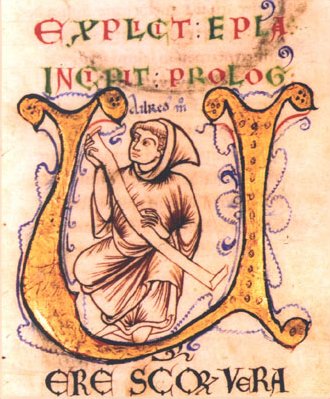
Portrait of Aelred of Rievaulx from “The Mirror of Charity” medieval manuscript, circa 1140 (Wikimedia Commons)
An icon of Saint Aelred was painted by Robert Lentz, a Franciscan friar and world-class iconographer known for his innovative icons. He faces controversy for his icons depicting same-sex couples. His Aelred image includes a banner with Aelred’s words, “Friend cleaving to friend in the spirit of Christ.” Prints of “Saint Aelred of Rievaulx” by Robert Lentz are available from Amazon and www.trinitystores.com.
It’s rare for a religious medal to show same-sex love between a pair of equals or to shows saints looking at each other. But that is what happens in the handmade pewter Saint Aelred medals by Louisiana artist Hank Schlau. Aelred and his friend stand face to face, arms on each other’s shoulders in the unusual and most appropriate design.
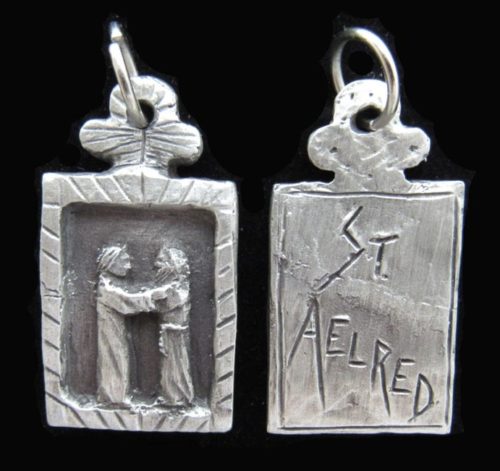
Handmade Saint Aelred medals by Hank Schlau are available at this Etsy shop his “In the Company of Saints” shop with a chain or without a chain.
“Because there are scant contemporary, realistic portraits of the great pre-modern saints and other holy persons, I think I taught myself to design, carve, and cast my own original statues and medals of these figures simply to see what I thought they might look like and, in some peculiar way, to converse with them, to try to understand something of what they knew,” he explains.
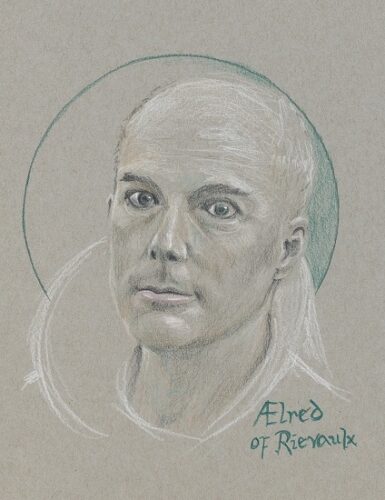
“Aelred of Rievaulx” by Tobias Haller
A bright-eyed icon of Aelred was sketched by Tobias Haller, an iconographer, author, composer, and vicar of Saint James Episcopal Church in the Bronx. He is the author of “Reasonable and Holy: Engaging Same-Sexuality.” Haller enjoys expanding the diversity of icons available by creating icons of LGBTQ people and other progressive holy figures as well as traditional saints. He and his spouse were united in a church wedding more than 30 years ago and a civil ceremony after same-sex marriage became legal in New York.
LGBTQ writing about Aelred of Rievaulx
Queer theologian Hugo Cordova Quero writes about Aelred in his scholarly article “Friendship with Benefits: A Queer Reading of Aelred of Rievaulx and His Theology of Friendship.” It is included in “The Sexual Theologian: Essays on Sex, God and Politics,” edited by Marcella Althaus-Reid and Lisa Isherwood.
Quero quotes and analyzes Aelred’s words from “The Mirror of Charity” on the death of his first close friend, a fellow monk named Simon. He goes on to explore Aelred’s subsequent love for an unnamed monk, putting his attachments to men into historical context with queer perspective. Click here to view the article online.
“Brother and Lover: Aelred of Rievaulx,” by Brian Patrick McGuire is a charming chronological account that traces the homoerotic impulse in Aelred’s life. McGuire, a history professor in Denmark, tells the story with a personal and informal writing style.
Aelred’s writings are discussed extensively in a 2015 book by a prominent evangelical scholar in the celibate LGBTQ Christian movement. Wesley Hill writes about friendship as a spiritual path, offering practical ways for building stronger friendships in “Spiritual Friendship: Finding Love in the Church as a Celibate Gay Christian.”
Aelred prayers
Q Spirit’s Litany of Queer Saints includes this line:
“Saint Aelred, who found divine love through his friendships with other men, pray for us.”
Links to LGBTQ interpretations of Aelred
12th January: St Aelred of Rievaulx, Patron of Same Sex Intimacy (Queering the Church)
Beloved Through Time: Spiritual Friendship, Queer Historiography, and the Kingdom of God: A Sermon by Max Yeshaye Brumberg-Kraus, Jan. 12, 2022 (stjohnsstpaul.org)
___
To read this post in Spanish / en español, go to Santos Queer:
San Elredo de Rievaulx: Santos gay de amistad
To read this post in Italian, go to
Aelredo di Rievaulx: il santo gay dell’amicizia (Gionata.org)
To read this post in Russian, go to:
Элред из Риво: гомосексуальный покровитель дружбы (nuntiare.org)
Oratio ad Christum Iris Arcus (Rainbow Christ Prayer in Latin)
___
Top image credit:
“Saint Aelred of Rievaulx and his Spiritual Friend” by Faithful Heretic
___
This post is part of the LGBTQ Saints series by Kittredge Cherry. Traditional and alternative saints, people in the Bible, LGBTQ martyrs, authors, theologians, religious leaders, artists, deities and other figures of special interest to lesbian, gay, bisexual and transgender and queer (LGBTQ) people and our allies are covered.
This article has evolved and expanded greatly since the first version was posted in January 2010. It was published on Q Spirit in January 2017, was enhanced with new material over time, and was most recently updated on Jan. 17, 2025.
Copyright © Kittredge Cherry. All rights reserved.
Qspirit.net presents the Jesus in Love Blog on LGBTQ spirituality.

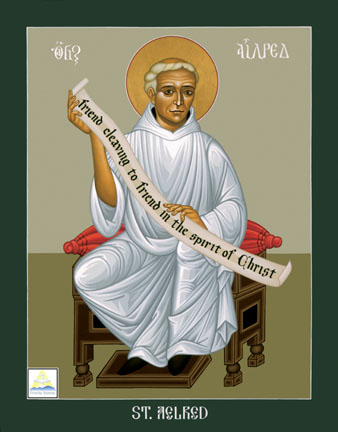



















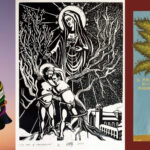


Boswell’s ideas have been debunked even by gay historians such as Alan Bray, and virtually all other historians. Even Wikipedia’s article on Aelred of Rievaulx says this, and summarizes the scholarly consensus (i.e. historians agree that Boswell was misinterpreting common monastic language that has nothing to do with romance or sex). It could be added that plenty of men have close friendships with other men, which is your article’s only justification for claiming he was gay.
You seem to be everywhere I go. I’m beginning to wonder how familiar you are with the primary sources. Have you ever read “De spirituali amicitia”? Here is the very first paragraph in the Prologue: “While I was still a boy at school, the charm of my companions gave me the greatest pleasure. Among the usual faults that often endanger youth, my mind surrendered wholly to affection and became devoted to love. Nothing seemed sweeter to me, nothing more pleasant, nothing more valuable than to be loved and to love.”
Speaking as a queer historian who primarily focuses on the queer Middle Ages, Boswell’s book is extremely outdated, and there are many problems in his research. However, today’s historians owe a huge debt to him for being a pioneer in the field. Perhaps the biggest problem here is that he calls Aelred a gay man. The term “gay” is new and anachronistic when speaking of the premodern world in particular. That does not mean that Aelred did not have sexual desire for other men.
Let’s cast aside the notion of sexual desire for a minute. In the quote above, he refers to his companions and their charms and says that he became devoted to love, both receiving it and the act of giving it. You can make the argument that what he really means is friendship, but if he did, then why did he not use the word “amicitia” as he does in the title? We can assume that his companions were other boys as he was at school, and girls would not have received this kind of education. Given this analysis, it makes sense that he felt love for other boys.
As it is, he was almost certainly celibate. If you refer back to my other comments, you’ll find the argument that one does not have to express love for their partners through sexual acts. I don’t stop loving my girlfriend when when we’re not having sex, and Aelred loved other men even though he wasn’t having sex with them.
As for your arguments, it’s almost comedic that you used Wikipedia as a source, and the fact that the only historian you were able to come up with was Alan Bray is disappointing. When you have actual research to back your claims up, please come back.
Citations: My Master’s degree in medieval European history with a focus on sexuality studies
McKenzie, I appreciate getting a detailed comment from a scholar who can quote Aelred and analyze the Latin vocabulary that he used. Your explanation of how one can experience sexual desire without acting upon it is helpful. Let me know if you recommend another author instead of Boswell for a queer overview of historical saints. My articles on LGBTQ saints may not always live up to your scholarly standards either, but my goal is to make them widely available to a general audience so they can find inspiration and do further research.
For questions about spiritual friendship and medieval monastic love, I highly recommend Medieval Sensibilities by Damien Boquet and Piroska Nagy and Ennobling Love: In Search of a Lost Sensibility by Stephen Jaeger, as well as anything by Barbara Rosenwein who specializes in medieval emotions.
Bernadette Brooten, Judith Bennet, and Helmut Puff all have extensive works on queer women in the Middle Ages. I would also recommend the Handbook of Medieval Sexuality, edited by Vern Bullough, who studied sexuality, and James Brundage, who studied sex in medieval law.
Overall though, the best introduction that you can have to the field is Medieval Sexuality: Doing Unto Others by Ruth Mazo Karras. It’s very accessible as she speaks in very plain, almost blunt language and although it’s a relatively short book, it’s packed full of information.
This is a reply to McKenzie since the system does not allow a direct reply (it would be a lot easier if it did, BTW).
You’re taking a cheap shot against me. The reason I used Wikipedia (and said “even Wikipedia’s article… says…”) is because 1) Wikipedia is rather left-leaning and yet it still rejects the idea that Aelred of Rievaulx was homosexual; and 2) it summarizes the consensus among historians against Boswell’s interpretation (in fact I said bluntly that it was summarizing the scholarly consensus). No, that doesn’t mean that Wikipedia is the only thing I’ve ever read, in fact I have translated medieval documents. I do not claim to specialize in Aelred of Rievaulx himself but you didn’t claim that either. The people who do specialize in studying him have said that he is unlikely to have been homosexual (in any sense of the term) as far as they can determine. In any event, my main point was that anyone who has studied the medieval period knows perfectly well that the people of that era used the word “love” very differently than in the modern pop culture, and monastic writing especially tends to use it a lot more freely and abstractly than people do in our society since monks and nuns generally used it to refer to the abstract love commanded in the Bible, which has nothing to do with romance. You seem to be making a big distinction between “amicitia” and “amor” although in that era there often wasn’t much of a distinction, and therefore Aelred of Rievaulx’s usage of the term does not imply romance.
No evidence exists that Aelred was gay – only conjecture. The ideas of Boswell and Brian Patrick McGuire are modern ideologies placed on a Christian medieval context.